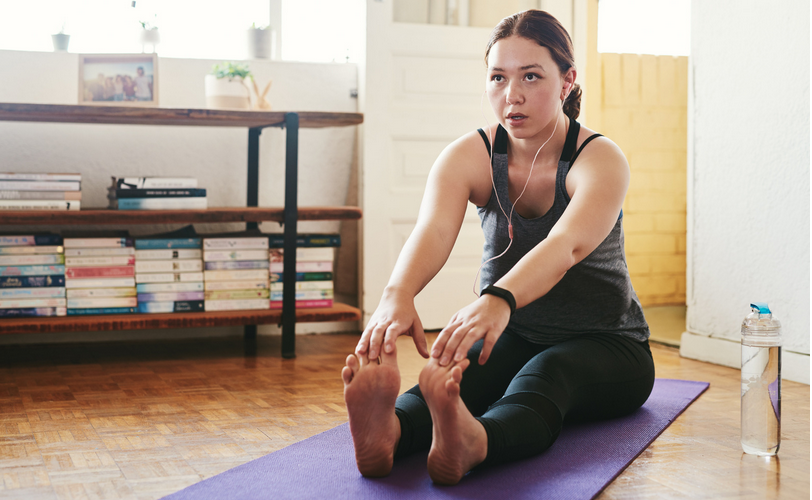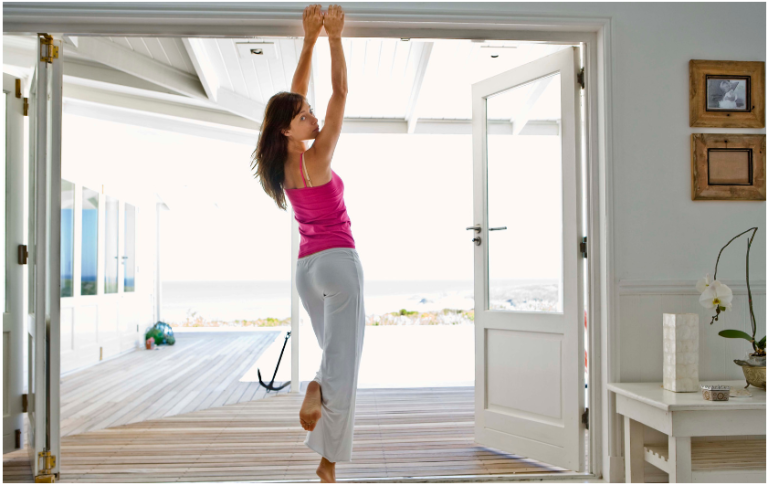
Stretching Should be Accompanied by Slow Deep Breaths?

Stretching is an essential part of any fitness routine. It helps to increase flexibility, range of motion, and circulation while reducing muscle tension. However, did you know that breathing techniques during stretching can enhance the benefits of stretching? Slow, deep breaths can help you release tension and relax your muscles, allowing you to stretch deeper and hold the pose longer.
When we breathe deeply, we increase the oxygen flow to our muscles, which can help them to relax and release tension. This allows us to stretch deeper without causing any pain or discomfort. Additionally, breathing deeply can help us stay focused and present during our stretching routine, enhancing the mind-body connection.
This article will explore the fundamentals of stretching and breathing techniques during stretching. We will also discuss best practices for safe stretching and answer frequently asked questions. By the end of this article, you will better understand how to incorporate breathing techniques into your stretching routine for maximum benefits.
Key Takeaways
- Slow, deep breaths can enhance the benefits of stretching by allowing you to stretch deeper and hold the pose longer.
- Breathing deeply can help you release tension and relax your muscles, reducing pain and discomfort during stretching.
- Incorporating breathing techniques into your stretching routine can enhance the mind-body connection and help you stay focused and present.
The Fundamentals of Stretching
Stretching is an essential part of any workout routine. It helps to improve flexibility, increase range of motion, and reduce the risk of injury. However, not all stretching is created equal. To get the most out of your stretching routine, it is important to understand the basics of stretching and the stretching types most beneficial for your body.
Understanding the Basics of Stretching
Stretching is lengthening and flexing your muscles to improve their elasticity. It is important to note that stretching should never be painful, and you should never push your body beyond its limits. Instead, it would help if you focused on holding each stretch for some time and breathing deeply to help relax your muscles.
There are two main types of stretching: static stretching and dynamic stretching. Static stretching involves holding a stretch in one position for some time, usually between 10 and 30 seconds. On the other hand, dynamic stretching involves moving your body through a range of motion to warm up your muscles before a workout.
Types of Stretching and Their Benefits
There are many different types of stretching, each with its unique benefits. Some of the most common types of stretching include:
- Static stretching: This type of stretching improves flexibility and range of motion. It is also an effective way to reduce muscle soreness and prevent injury.
- Dynamic stretching: This type of stretching is great for warming up your muscles before a workout. It helps to increase blood flow and oxygen to your muscles, improving your performance and reducing your risk of injury.
- Ballistic stretching: This type of stretching involves bouncing or jerking your body to stretch your muscles. It is not recommended, as it can cause injury and is ineffective in improving flexibility.
- Proprioceptive neuromuscular facilitation (PNF) stretching: This type of stretching involves contracting and relaxing your muscles while stretching. It is an effective way to improve flexibility and range of motion.
When it comes to stretching, finding a routine that works for you is important. It would help if you aimed to stretch at least two to three times a week, always listen to your body, and avoid pushing yourself too hard.
Related Posts:
- At What Point in Your Stretching Program Are You Likely to Notice Some Improvement?
- What Are The Recommended Training Variables For Dynamic Stretching
- 30-Day Free Stretching Program with Lisa Marie BodyRock (Bootcamp 2024)
Breathing Techniques During Stretching

Why Is Breathing Important During Stretching?
When stretching, it is important to breathe deeply and slowly. This is because deep breaths allow more oxygen to flow to the muscles, which in turn helps to improve blood flow. According to studies, deep breathing can also help to reduce stress and promote relaxation.
Inhaling deeply through the nose and exhaling slowly through the mouth can also help activate the diaphragm, an important muscle used in breathing. By using the diaphragm, we can take deeper breaths, which can help increase oxygen levels and promote relaxation.
How to Incorporate Deep Breathing into Stretching
To incorporate deep breathing into your stretching routine, try inhaling deeply as you begin to stretch and then exhaling slowly as you hold the stretch. You can also try counting to three as you inhale and then counting to three as you exhale to help regulate your breathing.
Another technique is to focus on your breath as you stretch. As you inhale, visualize the breath flowing into your body and filling your lungs with oxygen. As you exhale, visualize the breath leaving your body and taking any tension or stress with it.
Incorporating deep breathing into your stretching routine can help improve blood flow, increase oxygen levels in the body, and promote relaxation.
Related Posts:
Best Practices for Safe Stretching

Stretching is an important part of any exercise routine. It can enhance flexibility, decrease the risk of injuries, and improve overall flexibility. However, stretching should be done correctly to avoid any harmful effects. In this section, we will discuss the best practices for safe stretching.
Warm-Up Routines and Stretching
Before stretching, it’s crucial to warm up your muscles. Light aerobic exercises, such as jogging or jumping jacks, can do this. Warming up increases blood flow to the muscles and prepares them for the stretch you perform.
It’s important to perform each stretch slowly and hold it for 10-30 seconds. This will allow your muscles to relax and increase flexibility. Additionally, stretching should be accompanied by slow, deep breaths. This helps to increase oxygen flow to the muscles and reduce tension.
Identifying and Avoiding Harmful Stretches
Some stretching exercises can be harmful, even if performed correctly. It’s essential to identify these stretches and avoid them. For example, there are better forms of stretching than the ballistic method of developing flexibility. It involves bouncing or jerking movements, leading to muscle strains or tears.
When preparing to exercise, it’s best to warm up your muscles before stretching. Light aerobic exercises, such as jogging or jumping jacks, can do this. Warming up increases blood flow to the muscles and prepares them for the stretch you perform.
Arm circles are also considered a dangerous stretching exercise. They can cause shoulder injuries, especially if performed incorrectly. Avoiding this exercise and opting for safer alternatives such as shoulder rolls is best.
Identifying harmful stretches is crucial for preventing injuries. If you feel any pain or discomfort during a stretch, stop immediately. It’s also essential to stretch all major muscle groups, including the legs, hips, back, chest, shoulders, and arms.
Overall, stretching is an important part of any exercise routine. It can enhance flexibility, decrease the risk of injuries, and improve overall flexibility. However, performing each stretch correctly and avoiding harmful stretches is crucial.
Stretching is essential to enhance overall flexibility and decrease the risk of injuries. It’s important to perform each stretch slowly and hold it for 10-30 seconds. Additionally, stretching should be accompanied by slow, deep breaths. Identifying harmful stretches and warming up before stretching is also essential to prevent injuries.
Related Posts:
- 8 Partner Stretching Exercises To Enhance Your Yoga Practice
- The Ultimate Golf Stretching Program for Enhanced Performance
Frequently Asked Questions
What are the benefits of combining stretching with slow deep breathing?
Combining stretching with slow deep breathing has numerous benefits. It can help to increase flexibility and range of motion, reduce muscle tension, and improve blood circulation. Additionally, it can also help to reduce stress and anxiety levels.
How does slow deep breathing enhance the effectiveness of stretching exercises?
Slow, deep breathing helps oxygenate the muscles and increase blood flow, enhancing the effectiveness of stretching exercises. It also helps to relax the body and mind, allowing for a deeper stretch and more effective release of tension.
What are some common mistakes to avoid when stretching before a workout?
When stretching before a workout, avoiding overstretching, bouncing, or holding your breath is important. It is also important to avoid stretching cold muscles, which can increase the risk of injury. Instead, start with gentle movements and gradually increase the intensity of your stretches.
Why might some stretching exercises be harmful, and how can one stretch safely?
Some stretching exercises can be harmful if performed incorrectly or are not appropriate for your level of flexibility. Stretching safely by listening to your body, avoiding overstretching, and using proper form is important. It is also important to warm up before stretching and to avoid stretching cold muscles.
What stretching routine is recommended before engaging in a running session?
Before engaging in a running session, it is recommended to perform dynamic stretching exercises that mimic the movements of running. This can help warm the muscles and prepare them for the activity. Examples of dynamic stretches include walking lunges, high knees, and butt kicks.
What is a general rule when incorporating stretching into a warm-up routine?
When incorporating stretching into a warm-up routine, a general rule is to start with gentle movements and gradually increase the intensity of your stretches. It is also important to avoid overstretching, bouncing, or holding your breath. Remember to listen to your body and stop if you feel any pain or discomfort.



